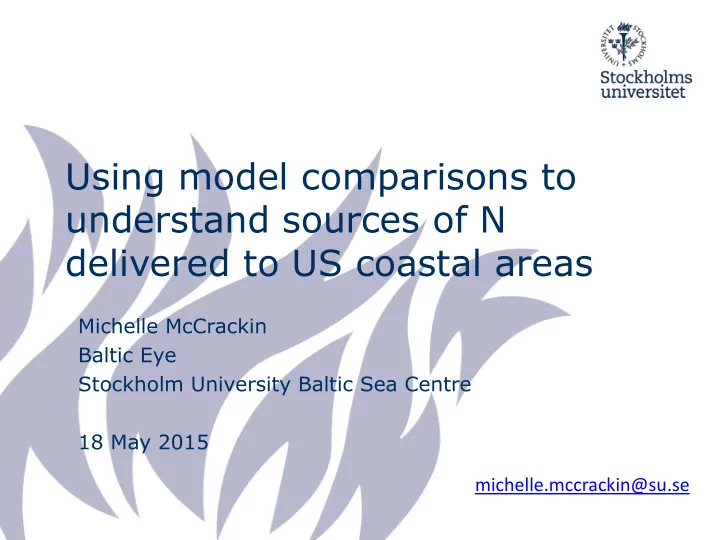

Using model comparisons to understand sources of N delivered to US coastal areas Michelle McCrackin Baltic Eye Stockholm University Baltic Sea Centre 18 May 2015 michelle.mccrackin@su.se
Context for analysis ● Recommendation: 25% reduction in N inputs ● Identifying N sources – Critical to achieve load reductions – Measuring source attribution is challenging – Limitations to isotope analyses NASA Earth Observatory
Trends in GoM NASA Earth Observatory
Past Model Comparisons 1 watershed in Estonia 17 watersheds in Europe Lidén et al. 1999 16 NE US watersheds EuroHarp Alexander et al. 2002
Multitude of Models HSPF : Hydrologic Simulation Program Fortran NANI : Net Anthropogenic Nitrogen Inputs NEWS : Nutrient Export from Watersheds NLM : Nitrogen Loading Model SWAT : Soil Water Assessment Tool SPARROW : Spatially Referenced Regressions On Watersheds WATERSN : Watershed Assessment Tool for Evaluating Reduction Strategies for Nitrogen Others… 5
Multitude of Models HSPF : Hydrologic Simulation Program Fortran NANI : Net Anthropogenic Nitrogen Inputs NEWS : Nutrient Export from Watersheds NLM : Nitrogen Loading Model SWAT : Soil Water Assessment Tool SPARROW : Spatially Referenced Regressions On Watersheds WATERSN : Watershed Assessment Tool for Evaluating Reduction Strategies for Nitrogen Others… 6
Study objectives Identify: ● important sources of N to US coasts ● areas of agreement/disagreement between NEWS and SPARROW ● factors that contribute to differences in predictions
Model overview NEWS SPARROW US Combines statistical and Hybrid statistical and Description mechanistic approaches; mechanistic approach simple, can be run in Excel 2 calibrated parameters 11 calibrated parameters Parameters estimated at global scale estimated at reach scale Non-significant predictors excluded Applied globally, 30-minute Applied at US national and Scale resolution; regional scale; US: 170 basins US: 7,000 US basins
Comparison of predictions
Comparison of yield predictions NEWS predictions: • within factor of 2 of SPARROW for >50% of catchments • within factor of 4 for 80% McCrackin et al. 2013
Human activities drive 70-90% of N delivered to US coastal zone NEWS SPARROW US 5% 11% 31% 32% 42% 21% 17% 20% 12% 9% McCrackin et al. 2013
Single-largest N sources NEWS and SPARROW agree for 67% modeled area McCrackin et al. 2013
Single-largest N sources NEWS SPARROW US McCrackin et al. 2013
Single-largest N sources McCrackin et al. 2013
Factors affecting differences in model predictions
Data inputs NEWS SPARROW US Fertilizer and Gridded global fertilizer and County-based fertilizer manure data from UN-FAO purchases Manure Manure estimated from livestock census Estimated N-fixation on Estimated N-fixation by key agricultural land (1.9 Tg/y) crops (7.3 Tg/y) - deposition (NADP) Atmospheric Modeled global TN deposition Wet NO 3 (Dentener 2006) deposition Sewage Human sewage as function of Human population GDP Natural N Estimated N-fixation on non- Surface area of forest, shrub, agricultural land (Cleveland et al. barren land 1999)
Uncertainties in input data National-level estimates Sobota et al. 2013
Model structure NEWS SPARROW US Function of runoff Function of temperature, soil Terrestrial N permeability, stream density retention Denitrification, dams, First-order decay Aquatic N irrigation water withdrawals retention
Baltic Sea applications?
Riverine sources to the Baltic Arheimer et al., 2013 Balt-HYPE PLC 5
Riverine N and P to the Baltic Balt-HYPE TN Diffuse/Agricul ture 19% TP Background 45% 20% Point/Sewage 16% Other
Recommend
More recommend